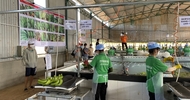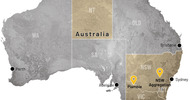Online Africa Policy Forum
By Loro Horta
While quite a lot of ink has been spilled over China’s scramble for African oil and mineral resources, little notice has been taken of its growing demand for food stuffs from Africa and for new agricultural land. As China grows wealthier, the eating habits of millions of its citizens have become far more demanding. In 1985, the Chinese consumed an average of 25 kilos of meat per person per year – today consumption has doubled to 50 kilos. The consumption of other food stuffs such as seafood, rice, soybeans, sugar, cereals and other crops has risen by 30 to 40 percent in the past decade. China’s growing demand for food and the rapid shrinking of available arable land in China itself due to environmental degradation and urbanization have made finding new agricultural lands an urgent priority for the Chinese government.
China’s search for new land has led Beijing to aggressively seek large land leases in Mozambique over the past two years, particularly in its most fertile areas, such as the Zambezi valley in the north and the Limpopo valley in the south. The Zambezi valley is the richest region of Mozambique with an area of 230,000 kilometers (88,800 square miles) spread between Tete and Zambezia provinces. The valley possesses some of the most fertile land in the world, as well as substantial resources below ground, such as coal, gold, and precious stones.
Chinese interest in the Zambezi valley started in mid-2006, when the Chinese state owned Exibank granted $2 billion in soft loans to the Mozambican government to build the Mpanda Nkua mega-dam on the stretch of the Zambezi in Tete province. Since then, China has been requesting large land leases to establish Chinese-run mega-farms and cattle ranches. A memorandum of understanding was reported to have been signed in June 2007, allowing an initial 3,000 Chinese settlers to move to Zambezia and Tete provinces to run farms along the valley. A Mozambican official said the number could eventually grow to up to 10,000. However, the reports of this deal caused such an uproar that the Mozambique government was forced to dismiss the whole story as false.
The government’s most recent denial came on May 15, 2008 when the minister for planning and development insisted that “It’s not true because the land in Mozambique is the property of the state and cannot be sold or rented.”
This line of argument seems rather disingenuous, since it is well known that hundreds of white South African farmers have been leasing land in Niassa since 1997, while since 2002 white farmers exiled from Zimbabwe have been given land in Manica province, in some instances with leases valid for 50 years. In any event, an official, perhaps speaking carelessly, has acknowledged that some sort of agreement has been reached concerning land leases and the movement of Chinese settlers to the valley.
One thing seems to be certain: China is committed to transforming Mozambique into one of its main food suppliers, particularly for rice, the basic element of Chinese diet. An analysis of China’s activities in the valley in the past two years provides some strong indication of China’s long term intentions.
In addition to the Mpanda Nkua dam, China has offered to finance three other dams along the Zambezi and two more along the Limpopo river, while also building new roads and modernizing the Guelimane and Nacala harbors in Zambezia and Nampula provinces respectively. This investment in infrastructure is clearly designed to maximize production and facilitate the rapid export of foodstuffs to China while also giving lucrative contracts to Chinese companies.
In tandem with dam building and transportation infrastructure, China has put significant resources into improving agricultural production, with rice as the main priority. In early 2008, the Chinese government pledged to invest $800 million in modernizing Mozambican agriculture, with the goal of boosting rice production from 100 000 tons to 500 000 tons a year in the next five years. With this objective in mind, China is funding the establishment of an Advanced Crop Research Institute and several other small agricultural schools throughout the country. Over 100 Chinese agricultural specialists are currently in Mozambique, including teams from the Hunan Hybrid Rice Institute, China’s top institution in the field. Other major projects include the construction of numerous irrigation and canal networks in the valley.
Mozambique’s increased rice production is clearly destined for export to the Chinese market, since the staple accounts for just a tiny fraction of the Mozambican diet and is primarily consumed in the big cities by the wealthy. Over 90 percent of the country’s population relies on mandioca (cassava) and shima (cassava flower), maize, and peanuts for its diet. Mozambique expects to receive hard currency from rice exports that will allow it in turn to buy Chinese made goods and other commodities in the world market. The lifting by the Chinese government of import tariffs for 400 Mozambican agricultural products, including rice, will further facilitate food exports to China.
However, Mozambican’s remember their country’s unhappy colonial experience under Portugal, and this has made the settlement of thousands of Chinese settlers a very contentious and emotional issue. During Portuguese rule, due to the richness of its land, the Zambezi valley was the most oppressed and exploited part of the country; and also the site of the greatest anti-colonial rebellions. The idea of moving thousands of Chinese settlers into the valley has caused great outrage locally, with many fearing the repetition of the dias negros (black days of oppression). This has led both the Mozambican government and the Chinese to be more discrete about their attentions, but not to abandon the idea.
China seems eager to go ahead with its farms along the Zambezi and has begun to apply pressure on the Mozambicans to approve the project. The Chinese are now linking the implementation of major projects such as dam construction and the funding for the Catembe Bridge – an important project that will link the capital, Maputo, to the district of Catembe across the bay – to concessions on the land lease issue. An inside source told the author that China has even hinted at the possibility of withholding loans for the mega- dam at Mpanda Nkua.
Due to the sensitivities aroused by the possible settlement of large numbers of Chinese agricultural workers in the valley, it’s most likely that a more modest arrangement will be worked out. Instead of thousands of Chinese settlers, it’s now more probable that a few hundred or perhaps 1,000 Chinese will move into the valley in coming years. The Chinese will manage the large farms, operate and maintain the advanced agricultural equipment, and maintain the canals, while Mozambican labor will do most of the manual work. On the land lease issue, the most likely compromise will be an arrangement by which a joint venture is created with nominal Mozambican participation, but very little doubt about who really runs the show.
While the Zambezi valley may offer China productive farmland and other opportunities, Beijing must be sensitive to local concerns lest its dreams for the valley turn into a public relations debacle that would damage China’s image on the continent. The history of Mozambique shows that the peoples of the Zambezi valley will not bow easily to the will of foreigners or to officials a thousand kilometers away in the capital. Their attachment to their land involves a great deal of spirituality as well as ancestral rights. Instead of trying to induce officials in Maputo to allow them entry into the valley, China would be better advised to listen to and negotiate with the people actually living there, since it is their land that China is banking on for its future food security.
If implemented with sensitivity, China’s agricultural plans could bring tremendous benefits for both sides, in the same way that white South African farmers have contributed to the development of Niassa despite the initial controversy over bringing in allegedly racist Boers who would exploit the local Mozambicans.
How successful China’s first agricultural investments in Africa will be remains to be seen. For the peoples of the Zambezi valley, land is extremely important and means more than just material benefits for those who own it. Through the centuries of Portuguese rule the fierce peoples of the valley showed that they don’t take it kindly being pushed off their land – something both Beijing and Maputo should keep in mind.
Loro Horta is a research associate fellow at the S. Rajaratnam School of International Studies, Nanyang Technological University, Singapore. He lived and worked in Africa for several years and has written extensively on Portuguese Africa. He spent seven years of his childhood in Zambezia province, and wishes dedicate this article to the memory Gonsalves, who saved him from drowning in the Zambezi when he was six years old. The views expressed here are strictly the author’s own.
[1] China in Africa: Implications for U.S. Policy: Stephen Morrison, director of the CSIS Africa program, delivered testimony on “China in Africa: Implications for U.S. Policy” before the Senate Committee on Foreign Relations Subcommittee on African Affairs.
[2] Angola and China: A Pragmatic Partnership. Indira Campos and Alex Vines, research assistant and head of the Africa Program at Chatham House, conducted extensive in-country interviews to examine the perceptions and impact of China’s engagement in Angola in a CSIS commissioned case study.
[3] China and Nigeria: Professor Pat Utomi, a political economist and senior faculty member at the Lagos Business School-Pan African University, conducted extensive in-country interviews to examine the perceptions and impact of China’s engagement in Nigeria in a CSIS commissioned case study.
[4] Economic Relations between Kenya and China: 1963-2007, Michael Chege, UNDP advisor to Kenya’s Ministry of Planning and National Development, conducted extensive in-country interviews to examine the perceptions and impact of China’s engagement in Kenya for a CSIS case study.
[5] China, Africa, and Oil: In this paper, Stephanie Hanson, News Editor at the Council on Foreign Relations, points out that China’s engagement in Africa is mainly driven by its increasing demand for energy and that China has become a major trade partner for Africa.
[6] Lessons Africans Must Learn from Chinese Expansion: Calestous Juma, professor at the Kennedy School of Government of the Harvard University, claims that a large part of the Chinese shift to Africa is due to the fact that China serves as an economic model for the continent.
[7] The Fact and Fiction of Sino-Africa Energy Relations. In this paper, Erica S. Downs, expert at the World Security Institute, demonstrates that China’s national oil companies are not locking up the lion’s share of African oil as part of a centralized quest for energy.
[8] Assessing China’s Growth Influence in Africa: Bates Gill, Chin-hao Huang, and Stephen Morrison argue that Africa is seen as integral to Beijing’s strategic ambition to adavnce a ’ new secuirty concept’ that can ensure China’s peaceful rise as a global power and strengthen relations with key neighbors and regions.
By Loro Horta
While quite a lot of ink has been spilled over China’s scramble for African oil and mineral resources, little notice has been taken of its growing demand for food stuffs from Africa and for new agricultural land. As China grows wealthier, the eating habits of millions of its citizens have become far more demanding. In 1985, the Chinese consumed an average of 25 kilos of meat per person per year – today consumption has doubled to 50 kilos. The consumption of other food stuffs such as seafood, rice, soybeans, sugar, cereals and other crops has risen by 30 to 40 percent in the past decade. China’s growing demand for food and the rapid shrinking of available arable land in China itself due to environmental degradation and urbanization have made finding new agricultural lands an urgent priority for the Chinese government.
China’s search for new land has led Beijing to aggressively seek large land leases in Mozambique over the past two years, particularly in its most fertile areas, such as the Zambezi valley in the north and the Limpopo valley in the south. The Zambezi valley is the richest region of Mozambique with an area of 230,000 kilometers (88,800 square miles) spread between Tete and Zambezia provinces. The valley possesses some of the most fertile land in the world, as well as substantial resources below ground, such as coal, gold, and precious stones.
Chinese interest in the Zambezi valley started in mid-2006, when the Chinese state owned Exibank granted $2 billion in soft loans to the Mozambican government to build the Mpanda Nkua mega-dam on the stretch of the Zambezi in Tete province. Since then, China has been requesting large land leases to establish Chinese-run mega-farms and cattle ranches. A memorandum of understanding was reported to have been signed in June 2007, allowing an initial 3,000 Chinese settlers to move to Zambezia and Tete provinces to run farms along the valley. A Mozambican official said the number could eventually grow to up to 10,000. However, the reports of this deal caused such an uproar that the Mozambique government was forced to dismiss the whole story as false.
The government’s most recent denial came on May 15, 2008 when the minister for planning and development insisted that “It’s not true because the land in Mozambique is the property of the state and cannot be sold or rented.”
This line of argument seems rather disingenuous, since it is well known that hundreds of white South African farmers have been leasing land in Niassa since 1997, while since 2002 white farmers exiled from Zimbabwe have been given land in Manica province, in some instances with leases valid for 50 years. In any event, an official, perhaps speaking carelessly, has acknowledged that some sort of agreement has been reached concerning land leases and the movement of Chinese settlers to the valley.
One thing seems to be certain: China is committed to transforming Mozambique into one of its main food suppliers, particularly for rice, the basic element of Chinese diet. An analysis of China’s activities in the valley in the past two years provides some strong indication of China’s long term intentions.
In addition to the Mpanda Nkua dam, China has offered to finance three other dams along the Zambezi and two more along the Limpopo river, while also building new roads and modernizing the Guelimane and Nacala harbors in Zambezia and Nampula provinces respectively. This investment in infrastructure is clearly designed to maximize production and facilitate the rapid export of foodstuffs to China while also giving lucrative contracts to Chinese companies.
In tandem with dam building and transportation infrastructure, China has put significant resources into improving agricultural production, with rice as the main priority. In early 2008, the Chinese government pledged to invest $800 million in modernizing Mozambican agriculture, with the goal of boosting rice production from 100 000 tons to 500 000 tons a year in the next five years. With this objective in mind, China is funding the establishment of an Advanced Crop Research Institute and several other small agricultural schools throughout the country. Over 100 Chinese agricultural specialists are currently in Mozambique, including teams from the Hunan Hybrid Rice Institute, China’s top institution in the field. Other major projects include the construction of numerous irrigation and canal networks in the valley.
Mozambique’s increased rice production is clearly destined for export to the Chinese market, since the staple accounts for just a tiny fraction of the Mozambican diet and is primarily consumed in the big cities by the wealthy. Over 90 percent of the country’s population relies on mandioca (cassava) and shima (cassava flower), maize, and peanuts for its diet. Mozambique expects to receive hard currency from rice exports that will allow it in turn to buy Chinese made goods and other commodities in the world market. The lifting by the Chinese government of import tariffs for 400 Mozambican agricultural products, including rice, will further facilitate food exports to China.
However, Mozambican’s remember their country’s unhappy colonial experience under Portugal, and this has made the settlement of thousands of Chinese settlers a very contentious and emotional issue. During Portuguese rule, due to the richness of its land, the Zambezi valley was the most oppressed and exploited part of the country; and also the site of the greatest anti-colonial rebellions. The idea of moving thousands of Chinese settlers into the valley has caused great outrage locally, with many fearing the repetition of the dias negros (black days of oppression). This has led both the Mozambican government and the Chinese to be more discrete about their attentions, but not to abandon the idea.
China seems eager to go ahead with its farms along the Zambezi and has begun to apply pressure on the Mozambicans to approve the project. The Chinese are now linking the implementation of major projects such as dam construction and the funding for the Catembe Bridge – an important project that will link the capital, Maputo, to the district of Catembe across the bay – to concessions on the land lease issue. An inside source told the author that China has even hinted at the possibility of withholding loans for the mega- dam at Mpanda Nkua.
Due to the sensitivities aroused by the possible settlement of large numbers of Chinese agricultural workers in the valley, it’s most likely that a more modest arrangement will be worked out. Instead of thousands of Chinese settlers, it’s now more probable that a few hundred or perhaps 1,000 Chinese will move into the valley in coming years. The Chinese will manage the large farms, operate and maintain the advanced agricultural equipment, and maintain the canals, while Mozambican labor will do most of the manual work. On the land lease issue, the most likely compromise will be an arrangement by which a joint venture is created with nominal Mozambican participation, but very little doubt about who really runs the show.
While the Zambezi valley may offer China productive farmland and other opportunities, Beijing must be sensitive to local concerns lest its dreams for the valley turn into a public relations debacle that would damage China’s image on the continent. The history of Mozambique shows that the peoples of the Zambezi valley will not bow easily to the will of foreigners or to officials a thousand kilometers away in the capital. Their attachment to their land involves a great deal of spirituality as well as ancestral rights. Instead of trying to induce officials in Maputo to allow them entry into the valley, China would be better advised to listen to and negotiate with the people actually living there, since it is their land that China is banking on for its future food security.
If implemented with sensitivity, China’s agricultural plans could bring tremendous benefits for both sides, in the same way that white South African farmers have contributed to the development of Niassa despite the initial controversy over bringing in allegedly racist Boers who would exploit the local Mozambicans.
How successful China’s first agricultural investments in Africa will be remains to be seen. For the peoples of the Zambezi valley, land is extremely important and means more than just material benefits for those who own it. Through the centuries of Portuguese rule the fierce peoples of the valley showed that they don’t take it kindly being pushed off their land – something both Beijing and Maputo should keep in mind.
Loro Horta is a research associate fellow at the S. Rajaratnam School of International Studies, Nanyang Technological University, Singapore. He lived and worked in Africa for several years and has written extensively on Portuguese Africa. He spent seven years of his childhood in Zambezia province, and wishes dedicate this article to the memory Gonsalves, who saved him from drowning in the Zambezi when he was six years old. The views expressed here are strictly the author’s own.
[1] China in Africa: Implications for U.S. Policy: Stephen Morrison, director of the CSIS Africa program, delivered testimony on “China in Africa: Implications for U.S. Policy” before the Senate Committee on Foreign Relations Subcommittee on African Affairs.
[2] Angola and China: A Pragmatic Partnership. Indira Campos and Alex Vines, research assistant and head of the Africa Program at Chatham House, conducted extensive in-country interviews to examine the perceptions and impact of China’s engagement in Angola in a CSIS commissioned case study.
[3] China and Nigeria: Professor Pat Utomi, a political economist and senior faculty member at the Lagos Business School-Pan African University, conducted extensive in-country interviews to examine the perceptions and impact of China’s engagement in Nigeria in a CSIS commissioned case study.
[4] Economic Relations between Kenya and China: 1963-2007, Michael Chege, UNDP advisor to Kenya’s Ministry of Planning and National Development, conducted extensive in-country interviews to examine the perceptions and impact of China’s engagement in Kenya for a CSIS case study.
[5] China, Africa, and Oil: In this paper, Stephanie Hanson, News Editor at the Council on Foreign Relations, points out that China’s engagement in Africa is mainly driven by its increasing demand for energy and that China has become a major trade partner for Africa.
[6] Lessons Africans Must Learn from Chinese Expansion: Calestous Juma, professor at the Kennedy School of Government of the Harvard University, claims that a large part of the Chinese shift to Africa is due to the fact that China serves as an economic model for the continent.
[7] The Fact and Fiction of Sino-Africa Energy Relations. In this paper, Erica S. Downs, expert at the World Security Institute, demonstrates that China’s national oil companies are not locking up the lion’s share of African oil as part of a centralized quest for energy.
[8] Assessing China’s Growth Influence in Africa: Bates Gill, Chin-hao Huang, and Stephen Morrison argue that Africa is seen as integral to Beijing’s strategic ambition to adavnce a ’ new secuirty concept’ that can ensure China’s peaceful rise as a global power and strengthen relations with key neighbors and regions.













